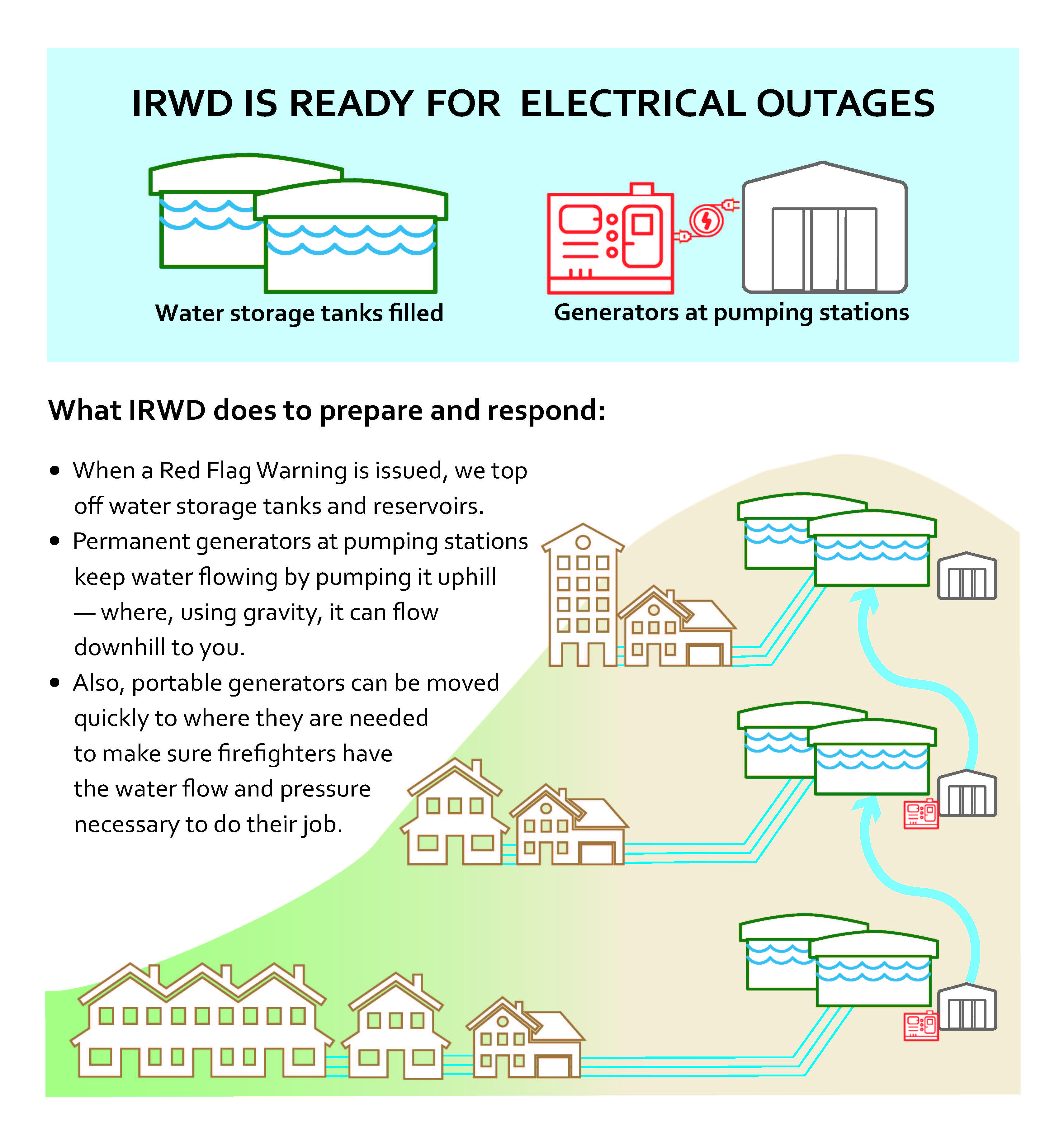Public Safety Power Shutoffs

Keeping the water flowing
High winds, low humidity and dry vegetation pose a real and growing threat of wildfires in California, particularly in late summer and fall.
To reduce that danger, electric utilities such as Southern California Edison will sometimes call a Public Safety Power Shutoff (PSPS) and turn off power in high-risk areas to reduce the likelihood of a wildfire starting from downed power lines and related equipment.
Irvine Ranch Water District is prepared to continue operating during these shutoffs and other events:
- Backup generators: Permanent generators are set up at all of IRWD’s critical facilities, and the District has portable generators that can be moved quickly to where they are needed. These generators help ensure that the IRWD has the power it needs to keep water and sewer systems operating. This is important in all areas that we serve, but it is critical in helping canyon and backcountry areas retain the fire flow necessary so that firefighters can do their job.
- Monitoring: Our staff watches local weather patterns and conditions that heighten fire risks, such as low relative humidity, strong winds, dry fuels, the possibility of dry lightning strikes or any combination of the above. This includes regular inspections of our facilities.
- A plan of action: During high-risk situations, IRWD takes action to prepare. This may include filling water storage tanks (which use gravity to deliver water to homes and businesses), mobilizing equipment and supplies to where they may be needed, and coordinating with other agencies to evaluate conditions and plan a coordinated response as needed.
- Communication: We maintain steady communication with other agencies and first-responders to make sure that hazardous conditions are addressed before problems strike.
- Alternative power sources: Several facilities have alternative sources of power such as solar to help supplement power needs.
Q: What does a PSPS mean to my water service?
- A: You should see no disruption in water service. IRWD has a procedure in place to avoid any disruption in service. Backup generators at the District’s critical facilities will provide power during a shutoff and portable generators can be moved to wherever they are needed to keep water and sewer services operating smoothly. Water storage tanks are filled ahead of time in high-risk conditions and use gravity to deliver water to customers’ taps.
Q: How much time does IRWD need to respond to an emergency?
- A: The District is ready to respond to emergencies quickly. IRWD monitors weather conditions to proactively prepare for threats before they become emergencies, and can respond at a moment’s notice. In the case of PSPS events, Southern California Edison typically issues a two-day notice and maintains communication with the District through a designated liaison who can help keep communication lines open when the need arises. In the event that a PSPS is called without notice, IRWD’s permanent generator stations kick on automatically whenever power is lost. Staff is trained to respond to a variety of emergency scenarios and to coordinate with regional agencies as needed.
Q: What can I do to prepare myself and my family for a PSPS?
- A: Plan ahead. If you live in a high-risk PSPS area, (typically a neighborhood surrounded by or bordering a large area of open space), here are some steps you can take to be ready:
-
- Keep an emergency supply of water, non-perishable food, and other items such as a cooler and ice on hand at all times.
- Install surge protectors to safeguard electronic equipment.
- Learn how to manually open automatic garage door openers or gates.
- An unopened refrigerator can keep foods cold for several hours. Open the door only when necessary.
- Keep your gas tank at least half-full so you can make it to a gas station outside of your PSPS area.
- For other tips, click here.
Q: How can I find out if I live in a high fire risk area?
Q: Where can I get more information?
- A: Here are some helpful resources:



